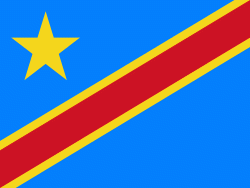Sud-Ubangi District (Sud Ubangi)
Sud-Ubangi (French for "South Ubangi") is one of the 21 new provinces of the Democratic Republic of the Congo created in the 2015 repartitioning. It lies in the northwest of the country on the Ubangi River.
Sud-Ubangi, Équateur, Mongala, Nord-Ubangi, and Tshuapa provinces are the result of the dismemberment of the former Équateur province. Sud-Ubangi was formed from the Sud-Ubangi district and the independently administered city of Zongo. The town of Gemena was elevated to capital city of the new province.
The capital of Sud-Ubangi is the town of Gemena. The separately administered city of Zongo was to be capital of the new province.
The territories of the province are:
* Budjala
* Gemena
* Kungu
* Libenge
Sud-Ubangi, Équateur, Mongala, Nord-Ubangi, and Tshuapa provinces are the result of the dismemberment of the former Équateur province. Sud-Ubangi was formed from the Sud-Ubangi district and the independently administered city of Zongo. The town of Gemena was elevated to capital city of the new province.
The capital of Sud-Ubangi is the town of Gemena. The separately administered city of Zongo was to be capital of the new province.
The territories of the province are:
* Budjala
* Gemena
* Kungu
* Libenge
Map - Sud-Ubangi District (Sud Ubangi)
Map
Country - Democratic_Republic_of_the_Congo
 |
 |
| Flag of the Democratic Republic of the Congo | |
Centered on the Congo Basin, the territory of the DRC was first inhabited by Central African foragers around 90,000 years ago and was reached by the Bantu expansion about 3,000 years ago. In the west, the Kingdom of Kongo ruled around the mouth of the Congo River from the 14th to 19th centuries. In the northeast, center and east, the kingdoms of Azande, Luba, and Lunda ruled from the 16th and 17th centuries to the 19th century. King Leopold II of Belgium formally acquired rights to the Congo territory in 1885 and declared the land his private property, naming it the Congo Free State. From 1885 to 1908, his colonial military forced the local population to produce rubber and committed widespread atrocities. In 1908, Leopold ceded the territory, which thus became a Belgian colony.
Currency / Language
| ISO | Currency | Symbol | Significant figures |
|---|---|---|---|
| CDF | Congolese franc | Fr | 2 |
| ISO | Language |
|---|---|
| FR | French language |
| KG | Kongo language |
| LN | Lingala language |















